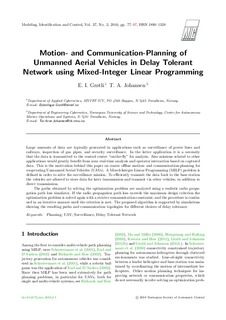| dc.contributor.author | Grøtli, Esten Ingar | |
| dc.contributor.author | Johansen, Tor Arne | |
| dc.date.accessioned | 2018-01-03T09:00:35Z | |
| dc.date.available | 2018-01-03T09:00:35Z | |
| dc.date.created | 2016-12-17T12:32:03Z | |
| dc.date.issued | 2016 | |
| dc.identifier.citation | Modeling, Identification and Control. 2016, 37 (2), 77-97. | nb_NO |
| dc.identifier.issn | 0332-7353 | |
| dc.identifier.uri | http://hdl.handle.net/11250/2474229 | |
| dc.description.abstract | Large amounts of data are typically generated in applications such as surveillance of power lines and railways, inspection of gas pipes, and security surveillance. In the latter application it is a necessity that the data is transmitted to the control centre ``on-the-fly'' for analysis. Also missions related to other applications would greatly benefit from near real-time analysis and operator interaction based on captured data. This is the motivation behind this paper on coarse offline motion- and communication-planning for cooperating Unmanned Aerial Vehicles (UAVs). A Mixed-Integer Linear Programming (MILP) problem is defined in order to solve the surveillance mission. To efficiently transmit the data back to the base station the vehicles are allowed to store data for later transmission and transmit via other vehicles, in addition to direct transmission. The paths obtained by solving the optimization problem are analyzed using a realistic radio propagation path loss simulator. If the radio propagation path loss exceeds the maximum design criterion the optimization problem is solved again with a stricter communication constraint, and the procedure is continued in an iterative manner until the criterion is met. The proposed algorithm is supported by simulations showing the resulting paths and communication topologies for different choices of delay tolerance. | nb_NO |
| dc.language.iso | eng | nb_NO |
| dc.rights | Navngivelse 4.0 Internasjonal | * |
| dc.rights.uri | http://creativecommons.org/licenses/by/4.0/deed.no | * |
| dc.title | Motion- and Communication-Planning of Unmanned Aerial Vehicles in Delay Tolerant Network using Mixed-Integer Linear Programming | nb_NO |
| dc.type | Journal article | nb_NO |
| dc.type | Peer reviewed | nb_NO |
| dc.description.version | publishedVersion | nb_NO |
| dc.source.pagenumber | 77-97 | nb_NO |
| dc.source.volume | 37 | nb_NO |
| dc.source.journal | Modeling, Identification and Control | nb_NO |
| dc.source.issue | 2 | nb_NO |
| dc.identifier.doi | 10.4173/mic.2016.2.1 | |
| dc.identifier.cristin | 1414392 | |
| dc.relation.project | Norges forskningsråd: 223254 | nb_NO |
| cristin.unitcode | 7401,90,23,0 | |
| cristin.unitname | Anvendt kybernetikk | |
| cristin.ispublished | true | |
| cristin.fulltext | original | |
| cristin.qualitycode | 1 | |

